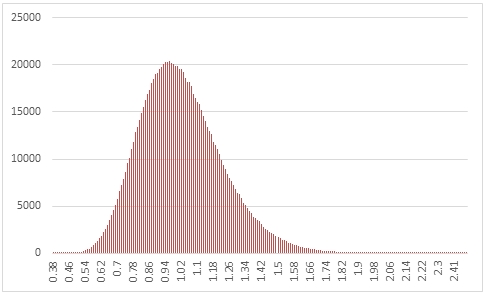SQL Server RANDFDIST Function
Updated 2023-10-18 15:50:18.283000
Description
Use the table-valued function RANDFDIST to generate a sequence of random numbers from an F-distribution with the degree of freedom parameters @df1 and @df2.
Syntax
SELECT * FROM [westclintech].[wct].[RANDFDIST](
<@Rows, int,>
,<@df1, float,>
,<@df2, float,>)
Arguments
@Rows
the number of rows to generate. @Rows must be of the type int or of a type that implicitly converts to int.
@df1
the first degree of freedom parameter. @df1 must be of the type float or of a type that implicitly converts to float.
@df2
the second degree of freedom parameter. @df2 must be of the type float or of a type that implicitly converts to float.
Return Type
table
{"columns": [{"field": "colName", "headerName": "Name", "header": "name"}, {"field": "colDatatype", "headerName": "Type", "header": "type"}, {"field": "colDesc", "headerName": "Description", "header": "description", "minWidth": 1000}], "rows": [{"id": "239b9d4d-f22a-4521-9158-c1ddda96a996", "colName": "Seq", "colDatatype": "int", "colDesc": "A monotonically increasing sequence number"}, {"id": "9a495c1f-b3ed-49c0-9b82-0efca06f904d", "colName": "X", "colDatatype": "float", "colDesc": "The random variable"}]}
Remarks
@df1 must be greater than zero.
@df2 must be greater than zero.
If @df1 is NULL then @df1 is set to 1.
If @df2 is NULL then @df2 is set to 1.
If @Rows is less than 1 then no rows are returned.
Examples
In this example we create a sequence 1,000,000 random numbers rounded to two decimal places from an F-distribution with @df1 = 100 and @df2 = 100, COUNT the results, paste then into Excel and graph them.
SELECT X,
COUNT(*) as [COUNT]
FROM
(
SELECT ROUND(X, 1) as X
FROM wct.RANDFDIST( 1000000, --@Rows
100, --@df1
100 --@df2
)
) n
GROUP BY X
ORDER BY X;
This produces the following result.

In this example we generate 1,000,000 random numbers from an F-distribution with @df1 of 100 and a @df2 of 100. We calculate the mean, standard deviation, skewness, and excess kurtosis from the resultant table and compare those values to the expected values for the distribution.
DECLARE @size as int = 1000000;
DECLARE @d1 as float = 100;
DECLARE @d2 as float = 100;
DECLARE @mean as float =
CASE
WHEN @d2 <= 2 THEN NULL
ELSE @d2/(@d2-2)
END;
DECLARE @var as float =
CASE
WHEN @d2 <=4 THEN NULL
ELSE (2*POWER(@d2,2)*(@d1+@d2-2))/(@d1*POWER(@d2-2,2)*(@d2-4)) END;
DECLARE @stdev as float =
CASE
WHEN @d2 <=4 THEN NULL
ELSE SQRT(@var) END;
DECLARE @skew as float =
CASE
WHEN @d2 <= 6 THEN NULL
ELSE ((2*@d1+@d2-2)*SQRT(8*(@d2-4)))/((@d2-6)*SQRT(@d1*(@d1+@d2-2)))
END;
DECLARE @kurt as float =
CASE
WHEN @d2 <= 8 THEN NULL
ELSE 12*((@d1*(5*@d2-22)*(@d1+@d2-2)+(@d2-4)*POWER(@d2-2,2))/(@d1*(@d2-6)*(@d2-8)*(@d1+@d2-2)))
END;
SELECT
stat,
[RANDFDIST],
[EXPECTED]
FROM (
SELECT
x.*
FROM (
SELECT
AVG(x) as mean_FDIST,
STDEVP(x) as stdev_FDIST,
wct.SKEWNESS_P(x) as skew_FDIST,
wct.KURTOSIS_P(x) as kurt_FDIST
FROM
wct.RANDFDIST(@size,@d1,@d2)
)n
CROSS APPLY(
VALUES
('RANDFDIST','avg', mean_FDIST),
('RANDFDIST','stdev', stdev_FDIST),
('RANDFDIST','skew', skew_FDIST),
('RANDFDIST','kurt', kurt_FDIST),
('EXPECTED','avg',@mean),
('EXPECTED','stdev',@stdev),
('EXPECTED','skew',@skew),
('EXPECTED','kurt',@kurt)
)x(fn_name,stat,val_stat)
)d
PIVOT(sum(val_stat) FOR fn_name in([RANDFDIST],[EXPECTED])) P;
This produces the following result (your result will be different).
{"columns":[{"field":"stat"},{"field":"RANDFDIST","headerClass":"ag-right-aligned-header","cellClass":"ag-right-aligned-cell"},{"field":"EXPECTED","headerClass":"ag-right-aligned-header","cellClass":"ag-right-aligned-cell"}],"rows":[{"stat":"avg","RANDFDIST":"1.02031428169584","EXPECTED":"1.02040816326531"},{"stat":"kurt","RANDFDIST":"0.742223766504818","EXPECTED":"0.727888318896645"},{"stat":"skew","RANDFDIST":"0.625057408675161","EXPECTED":"0.624361945733466"},{"stat":"stdev","RANDFDIST":"0.207189184603578","EXPECTED":"0.207245877669285"}]}
See Also
FINV - Calculate the inverse of the F probability distribution.
RANDBETA - Random numbers from a beta distribution
RANDBINOM - Random numbers from a binomial distribution
RANDCAUCHY - Random numbers from a Cauchy distribution
RANDCHISQ - Random numbers from a chi-squared distribution
RANDEXP - Random numbers from an exponential distribution
RANDGAMMA - Random numbers from a gamma distribution
RANDLAPLACE - Random numbers from a LaPlace distribution
RANDLOGISTIC - Random numbers from a logistic distribution
RANDNORMAL - Random numbers from the normal distribution
RANDPOISSON - Random numbers from a Poisson distribution
RANDSNORMAL - Random numbers from the standard normal distribution